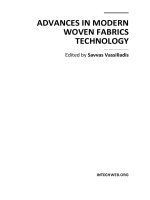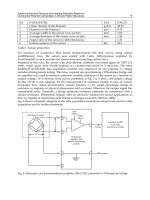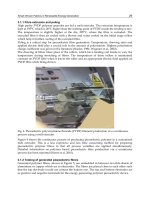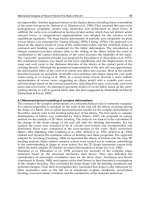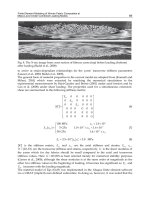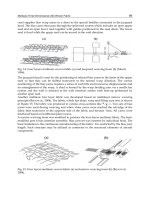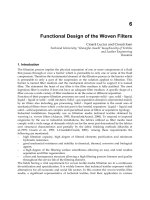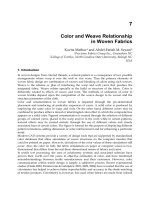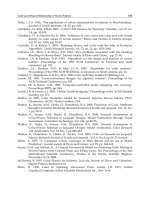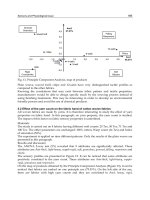Advances in Modern Woven Fabrics Technology Part 11 doc
Bạn đang xem bản rút gọn của tài liệu. Xem và tải ngay bản đầy đủ của tài liệu tại đây (1001.23 KB, 20 trang )
Superhydrophobic Superoleophobic Woven Fabrics
189
superhydrophobic and highly oleophobic once the fabric is treated with a low-surface-
tension material such as FS.
2.3.2.2 Superhydrophobic oleophobic twill woven structure
Fig. 8 shows a cross-sectional view of a model of a NyCo twill woven fabric made of
monofilament fibres. Flux integral can be used to obtain true area of twill woven fabric as
well. The area of one yarn in the unit fabric is:
2π 2π
22
2
00
yarn in unit area
R(2R Rcosv)dudv
πR8ππ
AR
3232
(30)
Fig. 8. Cross-section view of a twill woven fabric (source: Lee and Owens, 2010)
The area of one yarn in the unit fabric is applied to both weft and warp yarns, and a twill
fabric in Fig. 8 consists of four yarns in the unit area. Therefore, the true fabric area is:
true 2
fabric yarn in unit area
A 4x A 111.56R (31)
where A
true
fabric
is the intrinsic area of the unit fabric determined by the area of yarn surfaces.
The apparent surface area is equal to the area of a plane tangent to the top surface.
2
apparent
2
fabric
A R(2 3 1) 19.93R (32)
where A
apparent
fabric
is the apparent area of the unit fabric. Based on equation (10), the
roughness, r, is 5.59. If this twill woven fabric is made of yarns having multi-filament fibres
as shown in Fig 7, the fabric will have even higher values of roughness and r > 5.59, since
the space between the fibres will increase the intrinsic surface area whilst the apparent
surface area remains the same. Therefore, the twill woven rough surface has high enough r
to exist as a metastable Cassie–Baxter surface regardless of the structure of yarns.
Now, we model a Cassie–Baxter twill woven fabric. In Fig. 8, the centre-to-centre distance is
(2 3 1)R . Thus, a Cassie–Baxter NyCo surface is defined as:
CB
ee
re
4(πθ)1 4sinθ 1
cosθ cosθ 1
23 1 23 1
(33)
Substituting the same Young contact angles, 109º ≤ θ
e
(water) ≤ 112º and 73º ≤ θ
e
(dodecane)
≤ 75º, into equation (29), we obtain 142° ≤ θ
r
multi-filament
(water) ≤ 144° and 114° ≤ θ
r
multi-filament
Advances in Modern Woven Fabrics Technology
190
(dodecane) ≤ 115° for the FS-grafted multi-filament yarns. Using these values as the effective
contact angles for the yarns in the twill woven structure and re-solving equation (33), i.e.,
substituting these values into θ
e
(water) and θ
e
(dodecane) in equation (33), we predict 150°
≤ θ
r
CB
(water) ≤ 152° and 118° ≤ θ
r
CB
(dodecane) ≤ 119° for the FS-grafted multi-filament twill
woven fabric. According to our prediction, properly constructed NyCo multi-filament twill
woven fabric can also be superhydrophobic and highly oleophobic once the fabric is treated
with a low-surface-tension material such as FS.
2.3.2.3 Superhydrophobic oleophobic satin woven structure
Fig. 9 shows a cross-sectional view of a model of a NyCo 3/1 stain woven fabric made from
monofilament fibres. The surface area of a single round monofilament fibre in the unit fabric
can be calculated using flux integral in order to obtain r as shown above.
Fig. 9. Cross-section view of a 3/1 satin woven fabric
The area of one yarn in the unit fabric is:
2π 2π
2
22
00
yarn in unit area
R(2R Rcosv)dudv
8π
A πR π R
33
(34)
The area of one yarn in the unit fabric is applied to both weft and warp yarns, and the satin
fabric in Fig. 9 consists of six yarns in the unit area. Therefore, the true fabric area is:
real 2
fabric yarn in unit area
A 4 A 176.76R (35)
where A
true
fabric
is the intrinsic area of the unit fabric determined by the area of yarn surfaces.
The apparent surface area is equal to the area of a plane tangent to the top surface.
2
apparent
2
fabric
A 2R( 3 1) 29.85R (36)
where A
apparent
fabric
is the apparent area of the unit fabric. Based on equation (10), the
roughness, r, is 5.92. If this satin woven fabric is made of yarns having multi-filament
fibres as shown in Fig 9, the fabric will have even higher values of roughness and r > 5.92,
since the space between the fibres will increase the intrinsic surface area whilst the
apparent surface area remains the same. Therefore, the stain woven rough surface has
high enough r to exist as a metastable Cassie–Baxter surface regardless of the structure of
yarns.
Superhydrophobic Superoleophobic Woven Fabrics
191
Now, we model a Cassie–Baxter 3/1 satin woven fabric. In Fig. 9, the centre-to-centre
distance is (2 3 1)R . Thus, a Cassie–Baxter NyCo surface is defined as:
CB
ee
re
2(πθ)1 2sinθ 1
cosθ cosθ 1
31 31
(37)
Again, substituting the same Young contact angles above, 109º ≤ θ
e
(water) ≤ 112º and 73º ≤
θ
e
(dodecane) ≤ 75º, into equation (29), we obtain 142° ≤ θ
r
multi-filament
(water) ≤ 144° and 114°
≤ θ
r
multi-filament
(dodecane) ≤ 115° for the FS-grafted multi-filament yarns. Using these values
as the effective contact angles for the yarns in the 3/1 satin woven structure and re-solving
equation (37), we predict 149° ≤ θ
r
CB
(water) ≤ 151° and 117° ≤ θ
r
CB
(dodecane) ≤ 118° for the
FS-grafted multi-filament 3/1 stain woven fabric. According to our prediction, properly
constructed NyCo multi-filament satin woven fabric can also be superhydrophobic and
highly oleophobic once the fabric is treated with a low-surface-tension material such as FS.
NyCo multi-filament woven fabric can be superhydrophobic but cannot be superoleophobic
by itself, even if the fabric is treated with a low-surface-tension chemical. In order to achieve
superoleophobicity as well as superhydrophobicity, the fabric morphology has to be
manipulated by creating bigger spaces between fibres, loosening the fabric structure, or
providing more roughness to the surface of NyCo multi-filament fibres. Considering the
manufacturing process of woven fabrics, providing more roughness by adding
protuberances to the surface of NyCo fibres seems the easiest way to achieve
superhydrophobicity and superoleophobicity. Fig. 10 shows a NyCo surface covered with
protuberances in micro and nano size FS. In the next section, we study how to create such a
multi-scale roughness on the NyCo surface to prepare a metastable CB superhydrophobic
and superoleophobic woven fabric.
Fig. 10. A water drop on top of a NyCo fibre treated in a 10% FS solution consisting of base
catalyst.
2.3.2.4 Superhydrophobic superoleophobic woven fabric
By using FS in conjunction with corrugated, rough surfaces, FS can build multi-scale
roughness having low surface energy. Indeed, the previous research presented that the use
of condensed silanes increases micro and nano structure corrugation and results in
increased hydrophobicity and oleophobicity of so-treated cotton. A superhydrophobic and
superoleophobic NyCo woven fabric can be developed in the same manner by covalently
binding silanes onto the NyCo surface.
Although any soluble base can be an efficient catalyst, we use ammonium hydroxide as a
base catalyst to accelerate the displacement of the methoxy or ethoxy substituent, and to
facilitate the formation of the corrugated micro and nano-structure (Fig. 11).
Advances in Modern Woven Fabrics Technology
192
Fig. 11. Mult-scale protuberances on the FS-grafted NyCo surface. NyCo woven fabric was
treated in a 10% solution of FS with catalytic water (left) and NyCo fibres treated in 10% FS
with NH
4
OH (right)
Since FS-treated NyCo without catalytic base has a relatively smooth surface whilst NyCo
treated with FS in the presence of 1% catalytic base has multi-scale roughness on the surface,
the X-ray photoelectron spectroscopy (XPS) of both FS treated NyCo with and without base
catalyst was measured and compared with the XPS of untreated NyCo. Table 3 shows the
XPS atomic composition of C, N, O, F, and Si and the ratio of F/O, F/C, and F/Si at the
surface of three materials: (a) NyCo treated in a 10% solution of FS with catalytic water, (b)
NyCo treated in a 10% solution of FS in the presence of 1% NH4OH, and (c) untreated
NyCo. Both (a) and (b) have almost the same amount of fluorine regardless of the presence
of base catalyst. However, as shown in Fig. 11, NyCo treated in a 10% solution of FS with
water exhibits very different surface morphology compared to (b) although they possess
almost the same atomic composition of F and nearly the same values of F/O, F/C, and F/Si
ratios at the surface. As expected, based on the atomic composition of (c), the untreated
NyCo does not have fluorine on the surface.
Fabric
Atomic composition (%)
Ratio
C O F Si
F/O F/C F/Si
FS treated NyCo with water 39.1 8 50.2 2.7
6.3 1.3 18.4
FS treated NyCo with NH
4
OH 38.4 8.6 50.5 2.5
5.9 1.3 20.4
Control NyCo 77 20.5 0 1.4
0 0 0
Table 3. XPS atomic composition of FS treated and untreated NyCo
By changing FS concentration, curing time, and the number of cures, we can control the
morphology of FS protuberances on the NyCo surface and eventually prepare
superhydrophobic and superoleophobic woven fabric (Fig. 12). The FS-treated NyCo plain
woven fabric shown in Fig. 12 is superhydrophobic and superoleophobic. The fabric
prevents the absorption of not only water but also dodecane with almost no change of
contact angles.
Superhydrophobic Superoleophobic Woven Fabrics
193
Fig. 12. 10 µL water (left) and dodecane (right) droplets sitting on top of FS-grafted NyCo
plain woven fabric treated via microwave synthesis
The FS concentration, curing time, and the number of cures absolutely affect the wetting
behaviour of FS-treated NyCo woven fabric. This indicates that oil contact angles can be
greatly improved by varying such parameters. We suggest that improving the macro-scale
geometric morphology of the woven fabric, such as controlling the fibre spacing,
manipulating the yarn structure, and choosing the proper woven construction are also
necessary to design and prepare superhydrophobic and superoleophobic fabrics.
3. Conclusion
In this chapter, we studied how to create superhydrophobic and superoleophobic woven
fabric. A superhydrophobic superoleophobic surface is obtained by two criteria: a low
surface tension and a properly designed rough surface having appropriate surface
roughness and morphology. In order to make woven fabric superhydrophobic and
superoleophobic, NyCo multi-filament plain woven fabric was treated with FS which has a
very low surface tension and provides more roughness to the fabric by generating micro
and nano-size protuberances in the form of FS condensates on the fibre surfaces. From the
Young contact angles of water and dodecane on a FS-grafted nylon film, we could predict
the apparent contact angles on FS-grafted NyCo multi-filament plain, twill, and 3/1 satin
woven fabrics. Forming multi-scale geometric structure on the NyCo was also important to
improve hydrophobicity and oleophobicity of the fabric, and consequently this treatment
resulted in a highly hydrophobic and oleophobic woven fabric material. Finally,
superhydrophobic superoleophobic plain woven fabric has been prepared using the Wenzel
and the Cassie-Baxter equations. Although superoleophobicity is achieved via the
metastable Cassie-Baxter model, the fabric can prevent the absorption of oil as well as water
with almost no change of contact angles.
4. Acknowledgment
We appreciate support from the Defense Threat Reduction Agency-Joint Science and
Technology Office for Chemical and Biological Defense (contract numbers BA07PRO102 and
HDTRA1-08-1-0049) and Air Force Research Laboratory (grant number FA8650-07-1-5903).
The U.S. Government is authorized to reproduce and distribute reprints for Governmental
purposes notwithstanding any copyright notation thereon. The views and conclusions
contained herein are those of the authors and should not be interpreted as necessarily
Advances in Modern Woven Fabrics Technology
194
representing the official policies or endorsements, either expressed or implied, of Air Force
Research Laboratory or the U. S. Government.
5. References
Balkenede, A. R, Boogaard, H. J. A. P. van de, Scholten, M., Willard, N. P. (1998), ‘Evaluation
of different approaches to assess the surface tension of low-energy solids by means
of contact angle measurements’,
Langmuir, 14, 5907-5912.
Barton, A. F. M. (1983),
CRC Handbook of solubility parameters and other cohesion parameters,
Boca Raton, CRC Press, Inc.
Barthlott, W., Neihuis, C. (1997), ‘Purity of the sacred lotus, or escape from contamination in
biological surfaces’,
Planta, 202, 1-8.
Bico, J., Tordeux, C., Quere, D. (2001), ‘Rough wetting’,
Europhys Lett, 55, 214-220.
Brar, T., France, P., Smirniotis, P. (2001), ‘Heterogeneous versus homogeneous nucleation
and growth of zeolite A’,
J Phy. Chem B, 105, 5383-5390.
Chhowalla, M., Amaratunga, G. A. J., Milne, W. I., McKinley, G. H., Gleason, K. K. (2003), ‘
Superhydrophobic carbon nanotube forests’,
Nano Lett, 3, 1701-1705.
Fowkes. F. M. (1963), ‘Additivity of intermolecular forces at interfaces: I. Determination of
the contribution to surface and interfacial tensions of dispersion forces in various
liquids’,
J Phys Chem, 67, 2538-2541.
Fuerstner, R., Barthlott, W., Neinhuis, C., Walzel, P. (2005), ‘Wetting and self-cleaning
properties of artificial superhydrophobic surfaces’,
Langmuir, 21, 956-961.
Han, J. T., Xu, X., Cho, K. (2005), ‘Diverse access to artificial superhydrophobic surfaces
using block copolymers’,
Langmuir, 21, 6662-6665.
Hayn, R., Owens, J., Boyer, S., McDonald, R., Lee, H. (2011), ‘Preparation of highly
hydrophobic and oleophobic textile surfaces using microwave-promoted silane
couling’,
Journal of Materials Science, 46, 2503-2509.
Hoefnagels, H., Wu, D., With, G., Ming, W. (2005), ‘Biomimetic Superhydrophobic and
Highly Oleophobic Cotton Textiles’,
Langmuir, 23, 13158-13163.
Jopp, J., Gruell, H., Yerushalmi-Rozen, R. (2004), ‘Wetting behavior of water droplets on
hydrophobic microtextures of comparable size’,
Langmuir, 20, 10015-10019.
Kim, J., Kim, C. (2002), ‘Nanostructured surfaces for dramatic reduction of flow resistance in
droplet-based microfluidics’,
J Microelectromechanical System, 11(5), 454-464.
Kim, S. H., Kim, J., Kang, B., Uhm, H. (2005), ‘Superhydrophobic CF
x
coating via in-line
atmospheric RF plasma of He-CF
4
-H
2
’, Langmuir, 21, 12213-12217.
Kovats, E. (1989), ‘Wetting of low energy model surfaces’,
Pure and App Chem, 61, 1937-1944.
Krevelen, D. W. van, Hoftyzer, P. J. (1980),
Properties of Polymers, New York, Elsvier/North-
Holland Inc.
Krupenkin, T. N., Taylor, J. A., Schneider, T. M., Yang, S. (2004), ‘From rolling ball to
complete wetting: The dynamic tuning of liquids on nanostructured surface’,
Langmuir, 20, 3824-3827.
Kwong, V. H., Mossman, M. A., Whitehead, L. A. (2004), ‘Control of reflectance of liquid
droplets by means of electrowetting’,
App Optics, 43(4), 808-813.
Superhydrophobic Superoleophobic Woven Fabrics
195
Lau, K. K. S., Bico, J., Teo, K. B. K., Chhowalla, M., Amaratunga, G. J., Milne, W. I., McFinley,
G. H., Gleason, K. K. (2003), ‘Superhydrophobic carbon nanotube forests’,
Nano
Lett.
, 3, 1701-1705.
Lee, H., Michielsen, S. (2006), ‘Lotus effect: superhydrophobicity’,
Journal of Textile Institute,
97, 455-462.
Lee, H., Owens J. (2010), ‘Design of superhydrophobic ultraoleophobic nyco’,
Journal of
Materials Science
, 45, 3247-3253.
Lee, H., Owens J. (2011), ‘Motion of liquid droplets on a superhydrophobic oleophobic
surface’,
Journal of Materials Science, 46, 69-76.
Liu, H., Feng, L., Zhai, J., Jiang, L., Zhu, D. (2004)‚ ‘Reversible wettability of a chemical
vapor deposition prepared ZnO film between superhydrophobicity and
superhydrophilicity’,
Langmuir, 20, 5659-5661.
Marmur, A. (2004), ‘The Lotus effect: superhydrophobicity and metastability’,
Langmuir, 20,
3517-3519.
McHale, G., Shirtcliffe, N. J., Newton, M. I. (2004), ‘Contact-angle hysteresis on super-
hydrophobic Surfaces’,
Langmuir, 20, 10146-10149.
Miwa, M., Nakajima, A., Fujishima, A., Hashimoto, K., Watanabe, T. (2004), ‘Effects of the
surface roughness on sliding angles of water droplets on superhydrophobic
surfaces’,
Langmuir, 16, 5754-5760.
Nakajima, A., Hashimoto, K., Watanabe, T. (2005), ‘Transparent superhydrophobic thin
films with self-cleaning properties’,
Langmuir, 16, 7044-7047.
Ostrovskaya, L., Podesta, A., Milani, P., Ralchenko, V. (2003), ‘Influence of surface
morphology on the wettability of cluster-assembled carbon films’,
Europhys Lett,
63(3), 401-407.
Otten, A., Herminghaus, S. (2004), ‘How plants keep dry: A physicist’s point of view’,
Langmuir, 20, 2405-2408.
Pal, S. Weiss, H., Keller, H., Mueller-Plathe, F. (2005), ‘Effect of nanostructure on the
properties of water at the water-hydrophobic interface: a molecular dynamics
simulation’,
Langmuir, 21, 3699-3709.
Patankar, N. A. (2003), ‘On the modeling of hydrophobic contact angles on rough surfaces’,
Langmuir, 19, 1249-1253.
Roura, P., Fort, J. (2002), ‘Comment on “Effects of the surface roughness on sliding angles of
water droplets on superhydrophobic surfaces” ’
Langmuir, 18, 566-569.
Sun, M., Luo, C., Xu, L., Ji, H., Ouyang, Q., Yu, D., Chen, Y. (2005), ‘Artificial lotus leaf by
nanocasting’,
Langmuir, 21, 8978-8981.
Sun, T., Feng, L., Gao, X., Jiang, L. (2005), ‘Bioinspired surfaces with special wettability’,
Acc
Chem Res
, 38, 644-652.
Tadanaga, K., Morinaga, J., Matsuda, A., Minami, T. (2000), ‘Superhydrohpobic-
superhydrophilic micropatterning on flowerlike alumina coating film by the sol-gel
method’,
Chem Mater, 12, 590-592.
Yoshimitsu, Z., Nakajima, A., Watanabe, T., Hashimoto, K. (2002), ‘Effects of surface
structure on the hydrophobicity and sliding behavior of water droplets’,
Langmuir,
18, 5818-5822.
Advances in Modern Woven Fabrics Technology
196
Zhai, L., Cebeci F. C., Robert E. C., Rubner M. F. (2004), ‘Stable superhydrophobic coatings
from polyelectrolyte multilayers’,
Nano Lett, 4, 1349-1353.
Zhang, X., Sato, O., Taguchi, M., Einaga, Y., Murakami, T., Fujishima, A. (2005), ‘Self-
cleaning particle coating with antireflection properties’,
Chem Mater, 17, 696-700.
10
The Flame Retardant Nomex/cotton
and Nylon/Cotton Blend Fabrics
for Protective Clothing
Charles Q. Yang and Hui Yang
Department of Textiles, Merchandising and Interiors,
The University of Georgia,
U.S.A.
1. Introduction
Due to its excellent fire-resistant property, Nomex has commonly been used to produce
protective clothing [1, 2]. However, the high cost and low comfortability of Nomex have
limited its wider uses. Blending Nomex with cotton not only reduces the cost but also
improves comfortability of the fabrics. Because cotton is a highly flammable fiber, the
Nomex/cotton blend fabric containing more than 20% cotton is not self-extinguishable [3-4].
Therefore, a durable flame-retardant finishing treatment becomes necessary to make the
Nomex/cotton blend flame-resistant if it contains more than 20% cotton fiber.
Previously we developed a flame retardant finishing system for cotton based on a hydroxy-
functional organophosphorus oligomer (HFPO) shown in Scheme 1. Because HFPO does
not have a reactive functional group for cotton, it is necessary to use a bonding agent, such
as dimethyloldihydroxyethyleneurea (DMDHEU), trimethylolmelamine (TMM), or 1,2,3,4-
butanetetracarboxylic acid (BTCA), to make the flame retardant resistant to hydrolysis [5-
12]. In this research, we developed a nonformaldehyde flame retardant finishing system for
the Nomex/cotton using BTCA to bond HFPO to cotton by esterifying both HFPO and
cotton.
H
[
OCH
2
CH
2
O
P
O
]
2X
[
CH
2
O
OCH
2
]
O
P
X
OH
CH
2
CH
2
O
OCH
3
CH
3
Scheme 1. A hydroxy-functional organophosphorus oligomer (HFPO)
Considering the high cost of Nomex, nylon/cotton blend is a more attractive alternative for
use in protective clothing if the nylon/cotton fabric can be successfully flame retardant
finished. The industry is still not able to produce flame-resistant nylon fabrics in spite of
significant efforts made in the past 40 years [13-16]. It is even more difficult to impart flame
retardancy to a blend of cotton and a synthetic fiber, such as cotton/nylon blend, than to
each individual component fiber due to “scaffolding effect” [17]. The industry has yet to
Advances in Modern Woven Fabrics Technology
198
develop effective, practical and commercially feasible flame retardant finishing system for
nylon/cotton blend fabrics.
In this study, we investigated the bonding of HFPO onto nylon by DMDHEU, and found
that HFPO can be bound to the nylon fabric in the presence of DMDHEU by forming a
polymeric HFPO/DMDHEU system shown in Scheme 2. We also evaluated the
performance of two 50/50 nylon/cotton batter dress uniform (BDU) military fabrics treated
with HFPO/DMDHEU flame retardant finishing system.
HO
HO
C
O
CH
CH
CH
2
N
N
O
H
F
P
O
O
OCH
2
HFPO
O
HFPO
N
N
CH
2
CH
CH
O
C
CH
2
O
O
CH
2
C
O
CH
CH
CH
2
N
N
HFPO
O
O
O
HFPO
N
N
CH
2
OH
OHCH
CH
O
C
CH
2
O
H
F
P
O
O
O
Scheme 2. Formation of a Crosslinked Polymeric Network on Nylon
2. Experimental
2.1 Materials
The Nomex/cotton (35%/65%) blend fabric with woodland camouflage was a twill weave
fabric weighing 219 g/m
2
produced in China. The nylon fabric was a 100% nylon 6.6 woven
fabric (Testfabrics Style 306A) weighing 59 g/m
2
. Two nylon/cotton blend BDU fabrics
were used in this study: (1) a 50%/50% nylon/cotton BDU pure finish ripstop fabric printed
with three-color “day desert” camouflage weighing 216 g/m
2
(military specification: MIL-C-
44031 CL1); (2) a 50%/50% nylon/cotton BDU pure finish twill fabric with three-color
“woodland” camouflage weighing 220 g/m
2
(military specification: MIL-C-44436 CL3), both
supplied by Bradford Dyeing Association, Bradford, Rhode Island. HFPO under the
commercial name of “Fyroltex HP” (also known previously as “Fyrol 51”, CA Registry No.
70715-06-9) was supplied by Akzo Nobel Phosphorus Chemical Division, Dobbs Ferry, New
York. N-methylol dimethylphosphonopropionamide (MDPA) under the trade name of
“Pyrovatex CP New” (CA Registry No. 20120-33-6) was supplied by Ciba Specialty
Chemicals, High Point, North Carolina. DMDHEU was a commercial product (44%
agueous solution) under the trade name of “Freerez 900” supplied by Noveon, Cleveland,
Ohio. BTCA, triethanolamine (TEA) and hypophosphorous acid (H
3
PO
2
) were reagent-
grade chemicals supplied by Aldrich, Wisconsin.
The Flame Retardant Nomex/cotton and Nylon/Cotton
Blend Fabrics for Protective Clothing
199
2.2 Fabric treatment and laundering procedures
The fabric was first immersed in a finishing solution, then passed through a laboratory
padder with two dips and two nips, dried at 90C for 5 min and finally cured in a Mathis
curing oven. All concentrations presented here were based on weight of bath (w/w %). The
wet pick-up of the nylon/cotton blend fabrics was 77±2% whereas that of the Nomex/cotton
blend fabric was approximately 60±2%. After curing, the treated fabric was subjected to a
specified number of home laundering cycles using a standard reference detergent (AATCC
Detergent 1993) according to AATCC Test Method 124. The water temperature for
laundering was approximately 46C.
2.3 Evaluation of the flame retarding performance and stiffness of the fabric
The vertical flammability of the fabrics was measured according to ASTM Standard
Method D6413. The limiting oxygen index (LOI) of the fabrics was measured according to
ASTM Standard Method D2863. The fabric stiffness was measured according to ASTM
Standard Method D6828 using a “Handle-O-Meter” tester (Model 211-300) manufactured
by Thwing-Albert, Philadelphia. The slot width was 5 mm, and the beam size was 1000
grams. The fabric stiffness presented in this paper was the mean of measurements of 5
specimens.
2.4 Determination of phosphorus concentration on the treated fabric
Approximately 2 g of a treated fabric sample taken from three different parts of a “10 inches
× 12 inches” fabric specimen were ground in a Wiley mill into a powder to improve sample
uniformity. 2 ml of concentrated H
2
SO
4
were added to 0.1 g of the powder in a beaker. 10
ml of 30% H
2
O
2
were added dropwise to the mixture, allowing the reaction to subside
between drops. The reaction mixture was heated at approximately 250ºC to digest the
powder and to evaporate the water until dense SO
3
vapor was produced. The completely
digested sample as a clear solution was transferred to a 50 ml volumetric flask, then diluted
with distilled/deionized water. The sample thus prepared was analyzed with a Thermo-
Farrell-Ash Model 965 inductively coupled plasma atomic emission spectrometer
(ICP/AES) to determine the phosphorus concentration. The percent phosphorus retention is
calculated by: (the phosphorus concentration of the fabric after laundering) ÷ (that of the
fabric before laundering) x 100%.
3. Results and discussion
3.1 Flame retardant finishing of the 65/35 nomex/cotton blend military fabric
The phosphorus concentration of Nomex/cotton blend fabric treated with 24% HFPO, 8%
BTCA and 2.5% H
3
PO
2
in combination with TEA at different concentrations and subjected to
different home laundering cycles is presented in Figure 1. The data presented here show
that the phosphorus concentration on the treated Nomex/cotton blend fabric first increased,
then decrease as the TEA concentration increases in the range from 1.0% to 10.0% and the
maximum phosphorus concentrations on the treated fabric are achieved at 4% TEA (Figure
1). The data indicate that the use of TEA also increases the percent phosphorus retention on
the fabric after multiple laundering cycles. TEA has three hydroxyl groups in its molecule
and is able to react with carboxylic acid groups of BTCA by esterification. BTCA also reacts
with HFPO and cotton to form a BTCA/HFPO/TEA/cotton crosslinked network as shown
Advances in Modern Woven Fabrics Technology
200
in Scheme 3, thus improving the laundering resistance of the HFPO on cotton. The data
presented in Figure 1 also show that further increasing TEA concentration from 4% to 10%
reduces the retention of HFPO after multiple launderings on the treated fabric. Because
TEA, HFPO and cotton all have hydroxyl groups and they compete to react with BTCA, the
presence of excessive amount of TEA reduces the reaction of BTCA with HFPO and cotton,
thus reducing the bonding of HFPO on cotton as shown in Figure 1.
0.60
0.80
1.00
1.20
1.40
1.60
1.80
0.0 1.0 2.0 4.0 6.0 8.0 10.0
TEA Concentration (%)
Phosphorus concentration (%)
after 1 wash
after 10 washes
after 25 washes
Fig. 1. The phosphorus concentrations of the Nomex/cotton blend fabric treated by 24%
HFPO, 8%BTCA and 2.5% H
3
PO
2
as a function of TEA concentration.
The Nomex/cotton fabric is treated with 24%HFPO, 8%BTCA, 2.5% H
3
PO
2
and TEA at
different concentrations. The fabric thus treated is cured at 180ºC for 3 min. The LOI of the
fabric thus treated (before washing) is plotted against the TEA concentration in Figure 2.
Without being subjected to laundering, all Nomex/cotton fabric samples have the same
HFPO and H
3
PO
2
concentrations but different TEA concentrations. The LOI (%) of the
fabric increases from 37.2 to 40.6 as the TEA concentration (%) increases from 0.0 to 8.0%
(Figure 2). Thus, the data demonstrate the phosphorus-nitrogen synergistic effect of TEA in
the HFPO/BTCA/ H
3
PO
2
/TEA system on the Nomex/cotton blend fabric.
Previously, we found that calcium deposit formed on the cotton treated with HFPO/BTCA
during laundering diminishes the flame retardant performance of the treated cotton fabric
[11, 12]. We also studied the effects of TEA on the calcium deposit on the cotton fabric
treated with HFPO/BTCA [12]. The calcium concentration on the treated Nomex/cotton
blend fabric increases after multiple launderings is due to the formation of insoluble calcium
salt of those free carboxylic acid groups of BTCA bound to cotton. We also found that the
calcium concentration on the fabric after multiple launderings decreases as the TEA
concentration is increased. The reduction of the calcium concentration on the treated
The Flame Retardant Nomex/cotton and Nylon/Cotton
Blend Fabrics for Protective Clothing
201
Nomex/cotton blend fabric as a result of the presence of TEA is attributed to esterification
of the free carboxylic acid groups of BTCA on cotton by TEA as shown in Scheme 3.
TEA
O
OOC
C
C
O
O
COO
H
C
H
F
P
O
C
O
OC
CO
H
F
P
O
C
H
COO
O
O
C
C
OOC
O
TEA
TEA
O
OOC C
C
O
O
COO
H
C
H
F
P
O
COTTON CELLULOSE
CH
2
CH
2
CH
2
H
H
H
CH
2
CH
2
CH
2
Scheme 3. Formation of BTCA/HFPO/TEA crosslinked network on cotton
37
38
39
40
41
0.0 1.0 2.0 4.0 6.0 8.0
TEA Concentration (%)
LOI (%)
Fig. 2. LOI of the Nomex/cotton blend fabric treated by 24% HFPO, 8% BTCA and 2.5%
H
3
PO
2
in combination with TEA as a function of TEA concentration.
Advances in Modern Woven Fabrics Technology
202
The Nomex/cotton blend fabrics were treated with 24% HFPO, 8% BTCA, 2.5% H
3
PO
2
and
TEA at different concentrations. The Nomex/cotton blend fabric thus treated was cured at
180C for 3 min and finally subjected to 1, 10 and 25 laundering cycles. The LOI (%) of the
fabric thus treated is shown against the TEA concentration (Figure 3). After 1 laundering
cycle, the LOI of the treated Nomex/cotton blend fabric first increases from 32.1% without
TEA to its maximum (36.3%) when 6.0% TEA is used. Further increasing TEA concentration
reduces the LOI of treated Nomex/cotton blend fabric. Similar trends are observed on the
treated fabric subjected to 10 and 25 laundering cycles. The optimum TEA concentration for
the finish solution is in the 4.0-6.0% range. After 25 laundering cycles, the LOI of the fabric
treated using 6.0% TEA is 30.5%.
The Nomex/cotton blend fabrics was treated with HFPO/BTCA/TEA (weight ratio:
3.0/1.0/0.75) at different concentrations and curried at 180°C for 3 min. The HFPO
concentration increases from 12% to 24%, and the BTCA and TEA concentration are
increased accordingly. The LOI and vertical flammability (char length) of the treated fabric
after different laundering cycles are presented in Tables 1 and 2, respectively. The LOI of the
Nomex/cotton blend fabric without treatment is 22.9% and it fails the vertical flammability
test. All the Nomex/cotton fabric samples treated with the four HFPO/BTCA/TEA
formulas pass the vertical flammability test after 30 laundering cycles (Table 2). The fabric
treated with 12% (w/w) HFPO finishing solution (approximately 8% [w/w] HFPO on the
fabric) has LOI of 26.5% and char length of 48 mm after 30 laundering cycles, demonstrating
excellent flame retardant performance and superior laundering durability at a small flame
retardant concentration on the fabric.
24.0
26.0
28.0
30.0
32.0
34.0
36.0
38.0
0.0 2.0 4.0 6.0 8.0 10.0
TEA Concentration (%)
LOI (%)
after 1 wash
after 10 washes
after 25 washes
Fig. 3. The LOI of the Nomex/cotton blend fabric treated by 24%HFPO, 8%BTCA and 2.5%
H
3
PO
2
in combination with TEA as a function of TEA concentration.
The Flame Retardant Nomex/cotton and Nylon/Cotton
Blend Fabrics for Protective Clothing
203
HFPO
(%)
BTCA
(%)
H
3
PO
2
(%)
TEA
(%)
Number of home laundering cycles
before
wash
1
wash
10
washes
20
washes
30
washes
12 4 1.25 3.0 35.7 32.7 27.9 27.1 26.5
18 6 1.88 4.5 38.8 35.7 31.1 30.1 28.5
24 8 2.50 6.0 40.7 37.2 32.5 30.5 29.4
30 10 3.13 7.5 40.6 37.8 33.0 32.0 29.5
Control 22.9
Table 1. The LOI of the Nomex/cotton fabric treated with HFPO/BTCA/H
3
PO
2
/TEA at the
weight ratio of 24/8/2.5/6 and cured at 180C for 3 min.
HFPO
(%)
BTCA
(%)
H
3
PO
2
(%)
TEA
(%)
Number of home laundering cycles
No
wash
1 wash
10
washes
20
washes
30
washes
12 4 1.25 3.0 37 34 41 44 48
18 6 1.88 4.5 28 29 43 27 35
24 8 2.50 6.0 27 31 35 34 31
30 10 3.13 7.5 27 31 30 38 32
Control >300
Table 2. The char length of the Nomex/cotton blend fabric treated with
HFPO/BTCA/H
3
PO
2
/TEA at a weight ratio of 24/8/2.5/6 and cured at 180C for 3 min.
The tensile strength of the treated Nomex/cotton blend fabric is summarized in Table 3. The
tensile strength retention is 73-77% at the warp direction and 77-82% at the filling direction
(Table 3). The fabric strength loss is due to acid-catalyzed cellulose depolymerization and
crosslinking of cellulose [18]. The fabric strength loss after the flame retardant finishing
process is modest. The effect of the treatment on the fabric hand property appears to be
negligible. More details about the flame retardant Nomex/cotton blend fabric can be found
elsewhere [19].
HFPO
(%)
BTCA
(%)
H
3
PO
2
(%)
TEA
(%)
Tensile Strength
(N)
Strength Retention
(%)
Warp Filling Warp Filling
12 4 1.25 3.0 405 262 73 80
18 6 1.88 4.5 414 271 74 82
24 8 2.50 6.0 409 254 74 77
30 10 3.13 7.5 427 270 77 82
Control 556 329 - -
Table 3. The tensile strength of the Nomex/cotton blend fabric treated with
HFPO/BTCA/H
3
PO
2
/ TEA at the weight ratio of 24/8/2.5/6 and cured at 180C for 3 min.
3.2 The flame retardant finishing of nylon/cotton blend BDU fabrics
We first studied the bonding of HFPO to nylon fiber using DMDHEU as the bonding agent.
The nylon 6.6 fabric was first treated with the combination of 32% HFPO and DMDHEU at
Advances in Modern Woven Fabrics Technology
204
different concentrations, cured at 165 ºC for 2 min, and finally subjected to 1 and 10
laundering cycles. The phosphorus concentration and the percent phosphorus retention of
the nylon fabric thus treated are shown in Figure 4 and Table 4, respectively. When the
DMDHEU concentration is increased from 1% to 8%, the phosphorus concentration of the
treated nylon fabric after 1 laundering cycle increases from 0.21% to 1.75%, representing an
increase in phosphorus retention from 9% to 75%, respectively. After 10 laundering cycles,
1.04% phosphorus (45% retention) remains on the nylon fabric treated with 8% DMDHEU.
0
0.5
1
1.5
2
1.0 2.0 4.0 6.0 8.0
DMDHEU Concentration (%)
Phosphorus Concentration (%)
after 1 wash
after 10 washes
Fig. 4. The phosphorus concentration of the nylon-6.6 fabric treated with 32% HFPO and
DMDHEU cured at 165C for 2 min and finally subjected to 1 and 10 laundering cycles
versus TMM concentration.
HFPO
(%)
DMDHEU
(%)
Molar Ratio
(hydroxyl/hemi-
acetal*)
Phosphorus Retention (%)
1 wash 10 washes
32 1 6.19 9 8
32 2 3.10 12 10
32 4 1.55 52 11
32 6 1.03 65 38
32 8 0.77 75 45
* The molar ratio of the hydroxy group of HFPO to the methylol group of DMDHEU.
Table 4. The percent phosphorus retention of the nylon 6.6 fabric treated with 32%HFPO
and DMDHEU at different concentrations, cured at 165ºC for 2 min and finally subjected to
1 and 10 laundering cycles.
The Flame Retardant Nomex/cotton and Nylon/Cotton
Blend Fabrics for Protective Clothing
205
The concentration of the terminal amine groups of nylon 6.6 in the fiber is small. Due to the
poor penetration of the finishing solution into the fiber interior and the low reactivity of the
terminal amine groups as a result of a high degree of crystalinity and H-bonding in nylon
6.6, the concentration of phosphorus bound to the fabric by nylon’s terminal groups should
be even smaller. The phosphorus concentration of nylon fabric treated with 32%HFPO
without DMDHEU is 0.20% and 0.17% after 1 and 10 laundering cycles, respectively. The
phosphorus concentration on the nylon fabric after 1 laundering reaches 1.21, 1.52 and 1.75
when 4, 6 and 8% DMDHEU, respectively, is used for the treatment. The data indicate that
HFPO bound to the fabric is durable to multiple launderings. Therefore, the majority of
HFPO on the fabric must be bound to nylon by its reactions with DMDHEU other than its
bonding to nylon’s terminal groups by a DMDHEU “bridge”. DMDHEU has four
chemically active methylol groups, and HFPO has two hydroxyl groups. The increase in the
phosphorus retention as the DMDHEU concentration is increased shown here suggests the
formation of a crosslinked polymeric network. A simplified version of the crosslinked
polymeric network is shown in Scheme 2. The bonding of HFPO to the nylon fabric and the
retention of HFPO on the fabric after multiple launderings can probably be attributed to the
formation of the polymeric network on the fabric.
For the purpose of elucidating the bonding mechanism of HFPO to nylon by DMDHEU, we
applied N-methylol dimethylphosphonopropionamide (MDPA, shown in Scheme 4) to the
nylon fabric. A MDPA molecule has only one methylol group which may react with the
terminal amine groups on nylon but it is not able to from crosslinked network with HFPO.
The nylon 6.6 fabric was treated with 32% MDPA and DMDHEU at different concentrations,
cured at 165 ºC for 2min and finally subjected to 1 laundering cycle. The phosphorus
concentration of the nylon-6.6 fabric thus treated is presented in Table 5. The phosphorus
concentration on the nylon fabric treated using MDPA without DMDHEU is 2.53% before
laundering, and it becomes 0.23% after 1 laundering (Table 5). Considering the fact that the
same fabric treated with 32% HFPO without a bonding agent is 0.20% after 1 laundering, the
phosphorus concentration on the fabric thus treated (0.23-0.26%) is negligible. It is also
independent of the DMDHEU concentration used (Table 5). The small amount of MDPA
bound onto the nylon fabric is possibly due to (1) the reaction between MDPA and the
terminal amine group on the nylon fiber and (2) physical adsorption.
CH
3
O
CH
2
CH
2
OH
NH
O
C
CH
2
O
P
CH
3
O
Scheme 4. MDPA
HFPO is a bifunctional compound and it is able to form a crosslinked polymeric network by
its reaction with DMDHEU as shown in Scheme 2. Unlike HFPO, MDPA is mono-functional
and is not able to form a crosslinked polymeric network in the presence of DMDHEU. The
data presented here shows that the amount MDPA bound to nylon is negligible and is
independent of the amount of DMDHEU used. Those facts are consistent with the
hypothesis that HFPO reacts with DMDHEU on the nylon fabric to form a crossinked
polymeric network shown in Scheme 2, which makes HFPO on nylon resistant to
laundering.
Advances in Modern Woven Fabrics Technology
206
MDPA (%) DMDHEU (%) Phosphorus (%)*
32 0 0.23
32 2 0.26
32 4 0.25
32 6 0.24
32 8 0.23
Table 5. The phosphorus concentration of the nylon 6.6 fabric treated with 32% MDPA and
DMDHEU at different concentrations, then cured at 165C for 2 min, and finally subjected to
1 laundering cycle. (The phosphorus concentration on the fabric was 2.53% before
laundering.)
We applied two different formulas (HFPO/DMDHEU and MDPA/TMM) to the 50/50
nylon/cotton fabric (Table 6). The nylon/cotton fabric samples treated with the two
formulas have approximately the same phosphorus concentration (~3.80%) before
laundering. The fabric was cured at 165°C for 2 min and finally subjected to 10 laundering
cycles. The phosphorus concentration, LOI and char length of the fabric thus treated is
shown in Table 6. The nylon/cotton fabric treated with MDPA has 1.20% phosphorus
retained, and it has LOI of 23.9% and failed the vertical flammability test after 10
launderings. The fabric samples treated with HFPO/DMDHEU has LOI of 27.3% and passes
the vertical flammability test. Evidently, the MDPA/TMM system is not suitable for the
flame retardant finishing of the nylon/cotton blend fabric.
Flame
Retardant
Bonding
Agent
Catalyst
Phosphorus
(%)
LOI (%)
Char length
(mm)
HFPO 32%
DMDHEU
6%
NH
4
Cl
0.12%
2.20 27.3 75
MDPA 45% TMM 6% H
3
PO
4
2.0% 1.20 23.9 >300
Table 6. The LOI and char length of the 50/50 nylon/cotton blend fabric treated with
different flame retardants and different binders and subjected to 10 laundering.
The nylon/cotton fabric (woodland) is treated with 32% HFPO and DMDHEU at different
concentrations and cured at 165ºC for 2 min. The phosphorus concentration of the fabric
thus treated and subjected to different numbers of laundering cycles is shown in Table 7.
The phosphorus retention of the treated fabric is presented against the DMDHEU
concentration in Figure 5. When DMDHEU increases from 1% to 10%, the phosphorus
concentration of the treated fabric after one laundering increases from 0.56% (16%
phosphorus retention) to 2.69% (78% phosphorus retention). The percent phosphorus
retention after one laundering is also called “percent phosphorus fixation” by the industry.
A higher percent phosphorus fixation is a indicator of higher relative quantity of the flame
retarding organic phosphorus agent bound to the fabric after curing. Similar trend is
observed on the treated fabric after 20 and 40 launderings. The phosphorus concentration
and phosphorus retention decrease as the number of laundering cycle increases due to the
hydrolysis of the HFPO bound to the fabric. It is noticed that the fabric treated with 32%
HFPO and 10% DMDHEU after 40 laundering cycles still retains 1.84% phosphorus (54%
phosphorus retention).
The Flame Retardant Nomex/cotton and Nylon/Cotton
Blend Fabrics for Protective Clothing
207
HFPO (%) DMDHEU (%)
Phosphorus concentration (%)
1 laundering 20 launderings 40 launderings
32 1 0.56 0.30 0.25
32 2 1.34 0.52 0.42
32 4 1.81 0.72 0.64
32 6 2.47 1.79 1.01
32 8 2.59 2.00 1.13
32 10 2.69 2.18 1.84
Table 7. The phosphorus concentration of the nylon/cotton fabric (woodland) treated with
HFPO and DMDHEU at different concentrations and cured at 165C for 2 min. (The
phosphorus concentration of the treated fabric before wash is 3.43%.)
0
20
40
60
80
100
1246810
DMDHEU Concentration (%)
Phosphorus Rentention (%)
1 laundering 20 launderings 40 launderings
Fig. 5. The percent phosphorus retention of the nylon/cotton fabric (woodland) treated with
32%HFPO and DMDHEU at different concentrations and cured at 165C for 2 min.
The LOI and vertical flammability of the fabric thus treated is shown in Table 8 and Table 9,
respectively. As the DMDHEU concentration is increased from 1 to 10%, the LOI of the
treated fabric after 1 laundering cycle increases from 22.9 to 28.0%. The LOI decreases as the
number of laundering cycles for the fabric increases. The fabric treated using 6% or higher
DMDHEU concentrations passes the test after 40 launderings (Table 9). The LOI of the fabric
treated with 32% HFPO and 10% DMDHEU (after 40 laundering cycles) reaches 27.0% with
a char length of 81 mm. The data presented here clearly show that DMDHEU concentration
plays a critical role in determining the flame retardant performance of the nylon/cotton
blend fabric treated with HFPO/DMDHEU. A higher DMDHEU concentration increases the
amount of HFPO bound to the treated fabric and it also improves the hydrolysis resistance
Advances in Modern Woven Fabrics Technology
208
HFPO
(%)
DMDHEU
(%)
LOI (%)
1 laundering
10
launderings
20
launderings
40
launderings
32 1 22.9 22.2 21.6 21.2
32 2 25.0 23.2 22.5 22.2
32 4 26.5 25.1 23.0 22.7
32 6 27.7 27.1 26.8 24.8
32 8 27.9 27.5 27.2 25.8
32 10 28.0 28.0 27.4 27.0
Table 8. The LOI (%) of the nylon/cotton fabric (woodland) treated with HFPO and
DMDHEU at different concentrations and cured at 165C for 2 min. (The LOI (%) of the
untreated fabric is 20.1.)
of the HFPO bound onto the treated fabric by forming crosslinked HFPO/DMDHEU
polymeric network. In our previous research, we have discovered that the nitrogen of
DMDHEU does have a synergistic effect for the HFPO-based flame retardant system on
cotton [9], but this effect becomes less predominant on the nylon/cotton blends.
We applied the same flame retardant finishing system to a second nylon/cotton BDU fabric
(“desert”) with the same chemical composition but different structure. The fabric treated
with 32% HFPO and DMDHEU at different concentrations is subjected to different numbers
of laundering cycles. The LOI (%) and vertical flammability of the nylon/cotton blend fabric
(desert) thus treated are presented in Table 10 and 11, respectively. After l laundering cycle,
the LOI of the treated fabric increases from 28.0 to 28.5% as the DMDHEU concentration is
increased from 6 to 10%, respectively, and all three fabric samples pass the vertical
flammability test. As the number of laundering cycle increases, the difference among the
fabric samples treated using different DMDHEU concentrations becomes more evident.
After 25 launderings, the fabric treated with 6% DMDHEU has LOI of 23.8% and fails the
vertical flammability test, whereas that treated with 8% DMDHEU has LOI of 26.1% and
passes the flammability test. The fabric treated with 10%DMDHEU has LOI of 24.8% and
passes the vertical flammability test after 50 launderings. The data presented here again
demonstrate that DMDHEU plays a decisive role in determining the flame retardant
performance of the nylon/cotton blend fabric treated with HFPO and DMDHEU.
HFPO
(%)
DMDHEU
(%)
Char length (mm)
1 laundering
10
launderings
20
launderings
40
launderings
32 1 >300 >300 >300 >300
32 2 77 >300 >300 >300
32 4 80 94 >300 >300
32 6 77 99 88 114
32 8 79 66 83 105
32 10 49 62 68 81
Table 9. The vertical flammability of the nylon/cotton fabric (woodland) treated with HFPO
and DMDHEU at different concentrations and cured at 165C for 2 min.(The char length of
the untreated fabric is >300 mm.)
